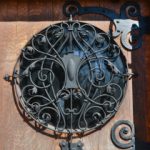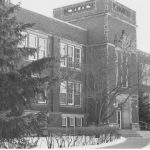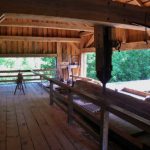Wilson Place Mansion in Menomonie, Wisconsin, was once the home of James Huff Stout (1848-1910), a lumber baron, longtime state senator, and philanthropist. He is best known for founding the Stout Institute, now the University of Wisconsin-Stout. According to local tradition, Stout Institute students fashioned the mansion’s front door as a gift honoring their school’s founder. Etched in the door’s heavy oak boards and wrought-iron embellishments is a unique legacy of educational innovation in Wisconsin history.
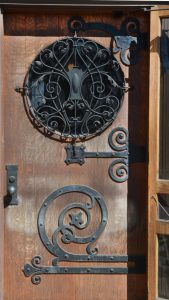
Stout supported a new approach to formal education in which students learned not only from textbooks, but also engaged in hands-on activities to gain advanced technical skills. In 1891, Stout established new programs offering technical education for boys and domestic science for girls through the Menomonie Public Schools. As Stout’s educational venture grew, the focus shifted from schoolchildren to college-age students. Paying for faculty salaries, state-of-the-art equipment, and even new buildings Stout helped pioneer a new approach to education in Wisconsin.
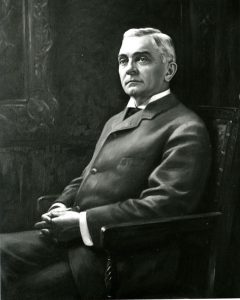
While Stout’s programs provided workplace skills, they were also heavily influenced by the Arts and Crafts Movement. Stout and his associates insisted that creativity and intellectual development were crucial parts of this new approach to education and encouraged activities not so obviously “vocational” in nature, including: drawing, jewelry making, embroidery, and photography. Stout’s visionary efforts flourished, forming an independent private school in just under two decades: the Stout Institute, incorporated in 1908. Tragically, Stout died just two years later, but ownership of the Institute transferred to the State of Wisconsin, ensuring that his legacy of educational innovation would live on. Indeed, UW-Stout is known to this day for its special mission of educating students for careers in design, industry, technology, and other fields demanding hands-on skills and applied expertise.
Today it is unknown exactly when the Wilson Place door was crafted and which students may have had a hand in its creation, but evidence suggests the door was indeed an artifact of Stout Institute education. The door’s hardware, scrollwork, and spiral embellishments not only reflect the content of Stout Institute course descriptions from the time, but also stylistically resemble the work of one its most well-known teachers: Thomas F. Googerty (1864-1945). Indeed, the door’s ironwork was so expertly forged it is quite likely that Googerty himself could have done much of the work.
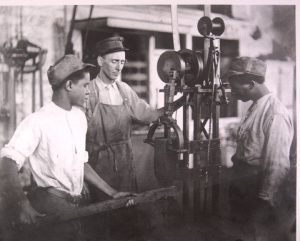
A nationally recognized, prize-winning artist and blacksmith, Googerty taught at the Stout Institute during the summer sessions from 1910 through 1917. Googerty also taught metalsmithing to juvenile inmates at a state reformatory in Pontiac, Illinois. Unlike most reformatory workshops, Googerty’s classes did not generate revenue for the institution. Instead, he sought to nurture inmate talents in hopes of improving their self-esteem and rehabilitating character, an occupation in keeping with the Stout Institute’s mission of providing self-fulfillment through vocational training. In addition to teaching class assignments that relate to the door’s design, Googerty authored three blacksmithing textbooks and several of their illustrations distinctly resemble some of the door’s features.
Although many uncertainties remain about the door’s origins, its style and craftsmanship nonetheless suggest the legacy of the Stout Institute. The heavy front door at Menominee’s Wilson Place opens an important era of Wisconsin’s rich educational history during which a new vision for learning prized students’ hands as much as their minds.
Written by James E. Bryan, March 2016.
SOURCES
Agnew, Dwight, James Huff Stout, Maker of Models, Menomonie, Wisconsin: University of Wisconsin-Stout, 1990.
Googerty, Thomas F., Hand Forging and Wrought-Iron Ornamental Work, Chicago, Illinois: Popular Mechanics, 1911.
Googerty, Thomas F., Practical Forging and Art Smithing, Milwaukee, Wisconsin: Bruce, 1915.
Googerty, Thomas F., Decorative Wrought Iron Work, Peoria, Illinois: Manual Arts Press, 1937.
Miller, Howard S. Forging Character, Forging Iron: The Work of Thomas F. Googerty, Memphis, Tennessee: National Ornamental Metal Museum, 1999.
Stout Institute Bulletin, vols. IV-XI, 1909-1916, Menomonie, Wisconsin.
The Wilson Place Museum, brochure, Menomonie, Wisconsin, c. 1976.
Thorie, Kevin, Interpreting the Dream: A Stout History, Menomonie, Wisconsin: University of Wisconsin-Stout, 1990.
University of Wisconsin-Stout Archives, Metal Works Projects, Icon Series 5, Box 3, Folder 1.

